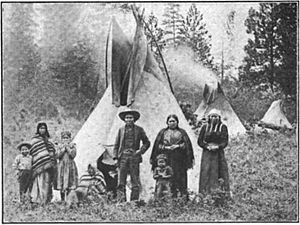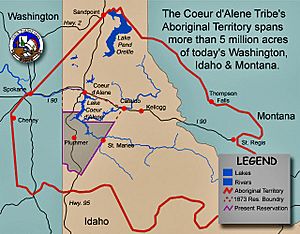Coeur d'Alene people facts for kids
| Schitsu'umsh Skitswish |
|
|---|---|

Coeur d'Alene people and tipis, Desmet Reservation, c. 1907
|
|
| Total population | |
| 1,976 (2015 census) | |
| Regions with significant populations | |
| Languages | |
| English • Coeur d'Alene |
The Coeur d'Alene Tribe (pronounced kur-də-LAYN) is a Native American tribe. They are one of five tribes in Idaho that the United States government officially recognizes. This recognition means they have a special relationship with the government.
The Coeur d'Alene Tribe has control over their own land, called the Coeur d'Alene Reservation. This land includes a large part of Lake Coeur d'Alene and the land under its waters.
In 2001, the United States Supreme Court decided that the Coeur d'Alene Tribe traditionally owned these lake lands. The court said the government had included this area in their reservation. This area was later named a "Superfund" site in 1983. A Superfund site is a place with a lot of pollution that needs cleaning up.
Because the cleanup was slow, the tribe sued mining companies in 1991. The United States government joined their lawsuit in 1996. Idaho also joined in 2011. The tribe reached agreements with the main companies in 2008 and 2011. These agreements provided money to help clean up dangerous waste. The funds also helped restore the natural environment.
Long ago, the Coeur d'Alene people lived on about 3.5 million acres of land. This land is now in northern Idaho, eastern Washington, and western Montana. They lived in villages along several rivers and lakes. Their native language is called Snchitsu'umshtsn. It is part of the Salish language family.
Contents
What Does "Coeur d'Alene" Mean?
The name Cœur d'Alêne comes from French and means "heart of an awl". An awl is a sharp, pointed tool. The Lewis and Clark Expedition first wrote down this name in 1805. French traders were said to have given the name to a tribal chief. He was known for being careful with his resources.
Another name for the tribe is Skitswish. This name was recorded by explorers in the early 1800s. It was a name used by other tribes.
The tribe's own name for themselves is Schi̲tsu'umsh. Some modern speakers say this name means "the discovered people." The tribe officially shortened its name to Coeur d'Alene Tribe.
Where Did the Coeur d'Alene Live?
Historically, the Coeur d'Alene people lived in the Idaho Panhandle region. This area also included parts of eastern Washington and western Montana. Their territory was huge, covering over 3.5 million acres. It had grassy hills, forests, lakes, and rivers.
The land stretched from Lake Pend Oreille in the north to the Clearwater River in the south. It went from the Bitterroot Mountains in the east to near Spokane Falls in the west. Lake Coeur d'Alene was right in the middle of their land. This area had many natural resources. These included fish like trout and salmon. The tribe also hunted and gathered plants. They used tools like spears and nets to catch fish.
A Look at Coeur d'Alene History
The Coeur d'Alene people first met Europeans in 1793. Before that, their way of life was based on fishing, hunting, and gathering plants. They moved seasonally to find food. In winter, they lived in semi-underground homes.
Early writings about the Coeur d'Alene come from fur traders. Alexander Henry the younger and David Thompson traded in their lands from 1810 to 1814. Henry wrote that the Coeur d'Alene were a large group. They had many horses because their land was open.
Another trader, Ross Cox, spent time at Spokane House between 1812 and 1817. He described the Coeur d'Alene as honest traders. He also wrote about a past conflict between the Coeur d'Alene and Spokane tribes. It started when a young man from one tribe disrespected a woman from the other. This led to fighting, but eventually, the tribes made peace. They even started marrying each other.
Many tribal members became Catholic in 1842. This happened because of Father Pierre-Jean De Smet, a Jesuit missionary. The towns of De Smet and Tensed are named after him. The United States took control of this land in 1846. More settlers started moving into the area in the 1840s.
After the Coeur d'Alene War in 1858, more people came. They were looking for silver, which was found in 1863. This area became one of the largest silver mining regions in the United States.
In 1873, the Coeur d'Alene lands were made much smaller. President Ulysses S. Grant created the Coeur d'Alene Indian Reservation. Chief Peter Moctelme traveled to Washington D.C. to talk about this. His tribe's land was reduced and sold to settlers.
Later, the reservation was made even smaller. It became about 345,000 acres near Plummer.
The Coeur d'Alene Tribe Today
Mining in the past caused a lot of pollution in the Coeur d'Alene area. This pollution included heavy metals in the water and air. It left millions of tons of waste in the river system.
Today, the Coeur d'Alene Tribe has about 2,000 members. They manage their own reservation. This includes the lower part of Lake Coeur d'Alene and the Saint Joe River. Many tribal members live in towns like DeSmet, Plummer, and Worley.
In 1949, the tribe approved its own constitution. They started electing representatives to a Tribal Council. In the 1950s, the U.S. government wanted to end its official recognition of some tribes. The Coeur d'Alene Tribe helped create the Affiliated Tribes of Northwest Indians. This group helped Salish tribes work together to keep their federal status.
The Coeur d'Alene Tribe also works with four other tribes in Idaho. They form the Five Tribes Council. They work together on projects and talk with the state government.
Tribal Economy
The tribe runs several businesses. These include the Coeur d'Alene Casino, Hotel, and Circling Raven Golf Club. These businesses are a big source of jobs and money for the tribe. The casino alone employs about 500 people. It generates millions of dollars each year. This money helps fund tribal programs and development.
The tribe also owns other businesses. These include an automotive center, a market, and an Ace Hardware store. They have also invested in a manufacturing plant and a bakery.
The tribal farm covers about 6,000 acres. It grows crops like wheat, barley, and peas. The tribe also manages its natural resources, including timber.
Coeur d'Alene Culture
The Coeur d'Alene people deeply respect nature and its laws. They believe in taking care of the environment. The tribe actively works to protect fish, wildlife, and natural resources.
Traditionally, the tribe had a flexible family system. They recognized relatives from both the father's and mother's sides. This allowed them to adapt to different living situations. They could live in different-sized groups depending on the season.
Environmental Efforts and Land Claims
In 1991, the Coeur d'Alene Tribe started the Coeur d'Alene Basin Restoration Project. Tribal leaders were worried that the cleanup of pollution was too slow. They decided to sue the mining companies. The United States government joined their lawsuit in 1996.
In 2008, one company, ASARCO LLC, agreed to pay $452 million. This money was for damages and cleanup at the Bunker Hill site. In 2011, another company, Hecla Mining Company, settled for $263.4 million. These funds are used to restore the natural environment. They help bring back fish, birds, and other wildlife. This was one of the largest settlements in Superfund history.
In a related case in 2001, the U.S. courts ruled in Idaho v. United States that the Coeur d'Alene Tribe has legal control over the submerged land of Lake Coeur d'Alene. This means the land under the lower part of the lake belongs to the tribe. The tribe has also worked with the U.S. Department of Justice. They sued the Union Pacific Railroad over pollution in the lake.
Coeur d'Alene in Movies
The movie Smoke Signals (1998) was set on the Coeur d'Alene Reservation. It was based on a story by Sherman Alexie. He is a writer who is part Spokane and Coeur d'Alene. Alexie wrote the movie's script and helped produce it. The film is about two young men from the reservation on a journey. All the actors and crew were Native American.
Notable Coeur d'Alene People
- Peter Moctelme (Chief, Coeur d'Alene Band 1907–1932)
- Sherman Alexie (Spokane-Coeur d'Alene), a famous author and filmmaker.
- Mildred Bailey (1907–1951), a popular jazz singer from the 1930s and 1940s. She was known as "Mrs. Swing."
- Ignace Garry, the last traditional chief of the Coeur d'Alene. He served from 1949 until his death in 1965.
- Joseph Garry, Ignace's son. He was the first Native American elected to the Idaho State House. He also served as Chairman of the Coeur d'Alene Tribe for 10 years.
- Jeanne Givens, a politician. In 1984, she was the first Native American woman elected to the Idaho State House.
- Janet Campbell Hale, a writer.
- Paulette Jordan, a politician who ran for governor of Idaho in 2018. She was also a member of the Idaho House of Representatives.
- Al Rinker, a musician and Mildred Bailey's younger brother. He was part of the popular trio "The Rhythm Boys" with Bing Crosby.
- Charles Rinker, a lyricist and Mildred Bailey's younger brother.
Images for kids
See also
 In Spanish: Coeur d'alene para niños
In Spanish: Coeur d'alene para niños






